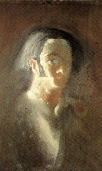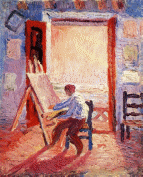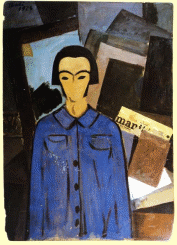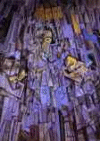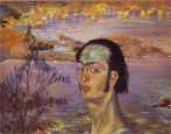Salvador Dali is a key figure in surrealist movement creating innovative approaches to art and artistic techniques. The unfitness and significance of this artist is that Dali made a great contribution to painting, sculpture, graphic and design, created new methods and techniques, new vision of reality and the world.
The most popular self portrays are: “Self-portrait” by teenage Dalí (1921), Self-portrait in the Studio (1921), Self Portrait with L’Humanite and Cubist Self Portrait with La Publicitat (1923), Self –Portrait with with Raphaelesque Neck (1921-1922) (see Appendix). His self-portraits can be seen as a unique part of his heritage reflecting ideas of personal self and self-identity, perception of the world and his genius.
The uniqueness and remarkable feature of his self-portraits is that Dali portrays himself in different images and through different lens underlining his unique personality and complex nature. From the historical point of view, the early 20th century was a period of tumultuous change. The First World War and the Russian Revolution profoundly altered people’s understanding of their worlds.
The discoveries of Freud and Einstein, and the technological innovations of the Machine Age, radically transformed human awareness. Dalí’s flamboyant showmanship, emblematized by his famous upturned moustache, is notorious, but the Dalí phenomenon warrants further attention precisely because students of modernism find the artist’s self-promotion so galling. Dalí posed difficulties for the Surrealists themselves.
The main feature of self-portraits is dream life themes and images used as a background of his works. For instance, in Self-portrait” by teenage Dalí flouted all the ideological protocols of Surrealism; as the 1930s progressed, he advocated both monarchist and Fascist sentiments. He also cultivated an innate fondness for kitsch, developing a fascination for the more excessive flourishes of Art Nouveau. His garish, showily accomplished, paintings were designed from the outset to be anti-aesthetic. His new style is akin to the self-searching, truth-revealing mode of Surrealism’s first phase.
To distinguish his own technique the artist draws a fine line between its lack of logical control, which smacks of catharsis or a spontaneous outpouring, and its having plenty of poetic logic, which is deemed to be the crucial divergence from Surrealism proper.
The last two distinctions are vital. In the first place, emphasis upon concreteness and plasticity is precisely what we find in Dali who described his paranoia-critical method. In addition to this obvious capacity to épater le bourgeois, excrement has a conceptual significance in Dalí that underpins one of his trademark images: namely, the soft texture he attributes to a range of solid objects.
Softness, in one sense, connects with putrefaction, as Dalí affirms: “In the acceptance of scatology, of defecation and death, there is a spiritual energy that I exploit with great consistency,” Self Portrait with L’Humanite and Cubist Self Portrait with La Publicitat differ from other works based on dream like background and themes.
Like other of his works, these self-portraits can be described them as ‘instantaneous color photography done by hand of the superfine, extravagant … superpictorial, superplastic, deceptive, hypernormal, feeble images of concrete irrationality.” Crazy, preposterous, delusional or simulated, Dalí’s parable amounts to a ‘conscious fantasy’ in which all the trappings of metamorphic symbolism — from the multiplication of fish to salvation through suffering — provide the material circumstance or composition by means of which Dalí transforms himself into the Creator and achieves the ultimate transubstantiation of the created work.
In all self-portraits, shame arouses anxiety which in turn finds expression in obsessive actions. These ‘neurotic ceremonials’, which compare with the modern ‘obsessive compulsive disorder’, consist of small daily rites that ‘have always to be carried out in the same, or in a methodically varied, manner’, if anxiety is to be obviated. It is the ‘special conscientiousness’ in executing the ritual that stamps the ceremonial as a ‘sacred act’, and it was this same conscientiousness, rather than emphasis upon any underlying meaning, that prompted Freud to conclude that there was ‘an essential similarity’ between the neurotic and religious patterns of behavior.
Dalí traces his own capacity to visualize the change of one object into another back to his childhood when he would stare at the stains on his classroom walls and imagine them take on ‘an increasingly precise, detailed and realistic personality’. When he tired of one image it would ‘instantaneously become metamorphosed into “something else” ‘, a process that could ‘go on to infinity.’
This theme, central to Dalí’s ‘paranoia-critical method’, underpins Cubist Self Portrait where materialist rigor combines with a fervent transcendentalism to create a manic form of mysticism. It also reflects his personal circumstance not only in terms of his religious upbringing but also as regards his artistic bent which brought contact with the likes of Maruja Mallo and artists of the Vallecas school. It is this dimension of his work that distinguishes him from writers for whom Surrealism was at bottom little more than a fashionable literary style. It is also the part of his work that has been most overlooked.
The most striking example of a purposeful deployment of psychical material for such ends is Dalí’s ‘paranoia-critical method’ which has the additional virtue of being cast in a metaphysical framework. The novelty of Dalí’s approach, lay in the fact that he showed himself to be ‘strong enough to participate in these events [of his unconscious] as actor and spectator simultaneously’. In other words, Dalí was able to treat his neuroses as subject matter while maintaining the critical detachment of an analyst towards a patient.
From 1928 on, his canvases typically consist of an array of objects that project and itemize his fetishes, the painter having considered these critically before structuring them into an artistic whole. The objects represent his inner life, their symbolic function having been teased out by self-scrutiny and by Dalí’s deliberate cultivation of his neuroses; but they are painted as objects in a naturalistic vein — with no sign of brushwork — to accentuate their concreteness.
Critics admit that Dalí’s simulated paranoia integrates the subjective and the objective: ‘The strong sense we have in Dalí of subject—object integration is enhanced by his fondness for compositions that combine humans with objects. His new style is akin to the self-searching, truth-revealing mode of Surrealism’s first phase. To distinguish his own technique the poet draws a fine line between its lack of logical control, which smacks of catharsis or a spontaneous outpouring, and its having plenty of poetic logic, which is deemed to be the crucial divergence from Surrealism proper.
Lack of vertical alignment is as important to the poem’s visual statement as the absence of punctuation and syntax is to its linguistic statement. Critics admit that its symmetry, or what Dalí in his calls ‘divine hypnosis of the mind’s geometry’, bears directly on Narcissus’s thoughts and relates organically to Dalí’s own personality and artistic principles. Few artists are as self-absorbed as Dalí whose obsessions provide the source material for his entire work.
At a personal level, it is equally plain that the Narcissus complex connects with both homosexuality and masturbation. The statuesque male who seductively displays his rear, and it might be added that Narcissus has turned his back on the heterosexuals behind him. in contrast to many of his woks, Dali does not portray sexual acts or the theme of masturbation in self-portraits. Dali’s attitude to the image hinged on the principle of the meeting of incompatible realties. This in turn says something about the way in which an alternative knowledge-system inevitably springs from ‘local’ rather than ‘universal’ roots.
However, the overriding impression is surely one of a compulsive fetishization of the body. This is the moment when the male child unconsciously disavows the mother’s lack of phallus, as evidenced by her apparent ‘castration’. The fetish thus stands in for the missing maternal phallus and symbolically allays the reminder of castration evoked by the sight of female genitalia. The more the fetish object is asserted, via multiplication or displacement onto other fetish objects, the more the threat recedes.
In sum, Dali’s self-portraits reflect his personality and unique perception of the world through the eyes of the artist himself. Much of the erotic art of Surrealism has a fundamentally symbolic and dream like character. Dream landscapes, populated with strange biomorphic forms established a theoretical justification for Surrealist painting.
Bibliography
Aramaki, Y. Soft Clocks. The Review of Contemporary Fiction, 22, 2002, p. 36. JSTOR Database.
Dali, S. Ades D. (2000). Dali’s Optical Illusions. Yale University Press.
Dali S., Chevalier H. M. The Secret Life of Salvador Dali. Dover Publications; Reprint edition, 1993. Duran, G. The Antipodes of Surrealism: Salvador Dalí and Remedios Varo. Symposium, 42, 1989, 297-310. JSTOR Database.
Conley, K. Surrealism and the Visual Arts: Theory and Reception. French Forum, 31, 2006, p. 166. JSTOR Database.
Descharnes R., Neret G. Dali: The Paintings. Taschen America Llc, 2001.
Mical, Th. Surrealism and Architecture. Routledge, 2004.
Easton, R. Canonical Criminalizations: Homosexuality, Art History, Surrealism, and Abjection. Differences, 4, 1992, p. 133-155. JSTOR Database.
Appendix
